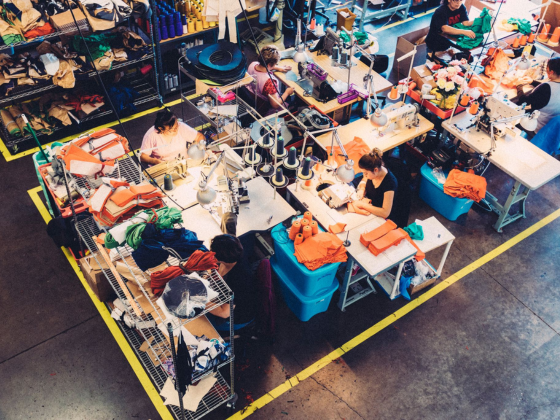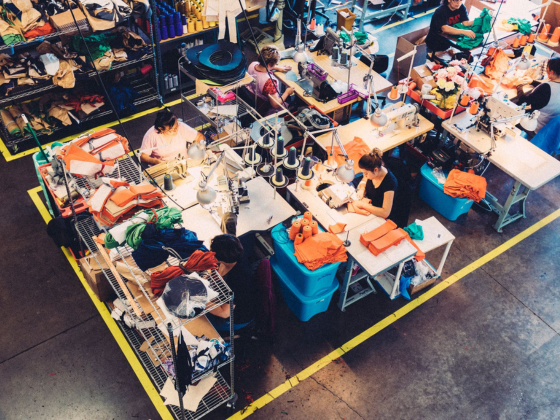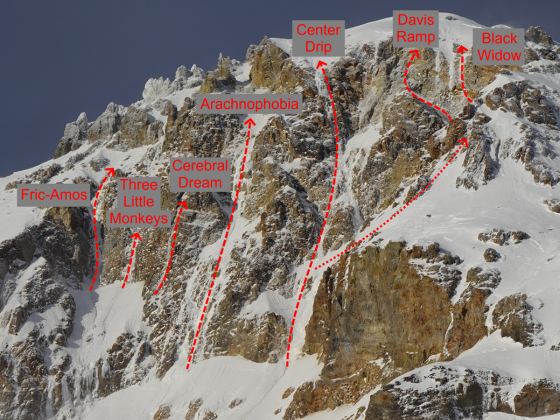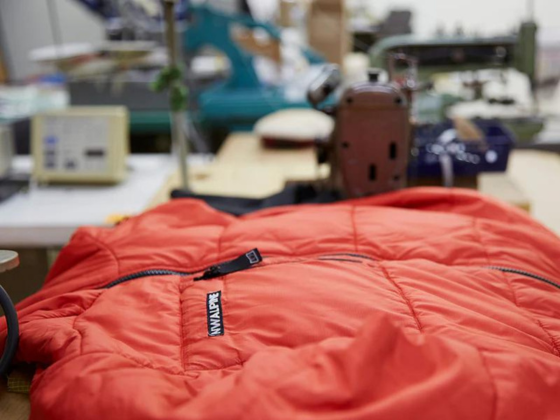I’m sure most folks that regularly see my posts know that I’m a huge proponent of American manufacturing and it has been the focus of my life’s work for the last fifteen years. I firmly believe that reshoring a significant portion of the products we consume is inevitable. I don’t believe that tariffs or trade policy will be necessary if we let the status quo continue. Our planet simply cannot sustain the level of production and consumption that the current system facilitates. You may have missed the recently released JP Morgan report acknowledging that we will blow past all Paris Agreement warming targets and that they are currently vetting investments under the assumption that we’ll reach three degrees warming by the end of the century. This is not coming from some left wing source, this is research from the world’s largest bank by market cap. There is overwhelming consensus among climate scientists that this level of warming will cause widespread and massive disruption to all of humanity.
We have to live in this world of our making and it's far preferable that we transition the economy in a controlled manner as opposed to letting it collapse and trying to rebuild in the aftermath. Unfortunately, collapse is more likely than a controlled transition, as large firms have far too much political power and will wring every cent of profit from the system until it is no longer possible. (See the previously mentioned JP Morgan report that talks about the massive profit potential in the doubling growth rate of the cooling market in the coming years, dark stuff.)
I’ve recently revisited Joseph Tainter’s work The Collapse of Complex Societies. Tainter argues that complex societies collapse when investments in complexity (things like global supply chains that rely on a massive military to keep the gears of trade turning) over time yield declining marginal returns (as they become more susceptible to climate related disaster and geopolitical turmoil) and the society can no longer bear these costs.
Collapse in this context does not necessarily mean widespread death and a mad max style future. He writes, “Collapse is a rapid transformation to a lower level of complexity, which means less specialization, less control, less information flow, less centralization, and less investment in the maintenance of sociopolitical systems.” and that, “A society that has collapsed is suddenly smaller, simpler, less stratified, and less socially differentiated. It is able to satisfy its members' needs through local production.”
So if I were the leader of the United States and wanted to re-shore manufacturing (apparel specifically) to ensure our citizens could continue to access the products we need for society to function, here’s how I’d do it:
- Define what the problem is- Even if they can’t articulate why, most people seem to understand that our current economic system is not working for the vast majority of Americans. Many of us are often pretty blind to this as when you reside in the top 10% the world looks awfully different than when you’re in the bottom 50%. Income inequality is out of control, monopoly and oligopoly crush competition. We may have access to cheap goods, but the cost of everything else has skyrocketed. By and large Americans have not benefited from the massive gains in productivity we’ve seen over the thirty years. Our largest employers are Walmart, Amazon, Target and Home Depot where workers stock shelves with goods made overseas, instead of sharing in the value add if they produced those goods. An economy based almost entirely on exporting dollars and absorbing the world’s production is not sustainable for the people or the planet and makes us far less secure as we are reliant on other countries that can cut off exports at any time.
- Have an actual plan- Businesses thrive when there is stability and certainty and leadership needs to articulate a clear long term vision for the future. Effective change is going to require bi-partisan political cooperation to ensure continuity of the plan as political leadership changes. Without this consensus there is no certainty that the next administration will not reverse all the policies and businesses will be reluctant to make large investments in capacity. Domestic yarn spinning will be a bottleneck in textile production. It has been hit hard recently with a number of plants going out of business. Certainty that demand will be there will be necessary for large capital investments to be made.
- Regulations and tax incentives- I never found regulations to be particularly burdensome running a cut and sew in Oregon (a regulation heavy state). But this kind of light manufacturing is not particularly emissions heavy. Dye houses for textiles use a lot of water, but there are a number of mills that operate in downtown Los Angeles, which has some of the strictest environmental regulations in the world, and sell fabric at globally competitive prices. We will need to accept that when we make things here there will be waste and emissions. We’ve enjoyed thirty years of being able to offload those externalities onto other countries. Making things here will require brands and their factories to take ownership of these externalities. It’s one thing to pollute someone else’s rivers, it’s quite another to pollute the one in your backyard.
The federal government will need to provide tax incentives, perhaps in the form of payroll tax breaks. A large tax burden on manufacturers, at least here in Oregon and may differ in other states, is from personal property tax, usually levied by counties. So as manufacturers expand their annual personal property tax increases as they buy more equipment. The federal government can work with counties to make up lost revenue from the elimination of personal property taxes for manufacturers.
States and counties must make it easier to zone land for light industrial and build industrial real estate, and can provide tax incentives to drive construction.
- Tariffs- Targeted tariffs can help, focused on finished goods first. But labor rates are so much higher here that tariffs would have to be astronomically high to make a difference. A return to a quota system like the Multi-Fibre Agreement may be more appropriate. Most textile and apparel manufacturing equipment is made elsewhere and must be exempt from tariffs, at least at the beginning of the project.
- Immigration reform- We must face the reality that, like much of the developed world, the demographics of our country are not primed for growth. Most apparel factories in the US are staffed by immigrant populations from countries where sewing is still taught and practiced. A comprehensive immigration policy, perhaps with a guest worker program, that easily allows manufacturers to legally employ people and gives the worker a path to citizenship for their help in rebuilding our manufacturing economy. This will be especially important in the beginning stages of the project.
- Workforce training- This needs to go hand-in-hand with immigration reform. Millions of Americans currently work in low wage retail jobs, i.e. Walmart, that pays so poorly that many of their employees must rely on federal assistance to get by. Factory work has gotten a bad rap in this country, but those are the jobs that built the post-war middle class, and they can again. There is dignity in making the products that your neighbors use and when American workers are paid a greater share of the value add from the products that are consumed here they will collect higher wages. As late as 1990 half of all apparel sold in the US was made here by workers paid American wages. I don’t remember many people walking around unclothed in the 1990s.
We’ll need to start training programs for garment manufacturing in high schools and community colleges. Factory workers won’t be stopped out at the sewing machine operator position. There are plenty of opportunities for advancement in a factory setting. From pattern making and technical design, to logistics and supply chain. Some of those employees will leave and start their own factories. This is a classic path to upward mobility that is currently missing in our country for many people. We will also need to figure out how to train mechanics, industrial engineers and plant managers, as those with experience are very hard to find here.
The federal government will need to plow funding into NIST to expand and fully fund each state’s Manufacturing Extension Partnership programs and offer their consulting services free of charge. Factories in low wage countries don’t need to run efficiently because their payroll is effectively non-existent in comparison. When you pay American wages, ruthlessly eliminating non-value added time is imperative.
- Drive demand for US made products- None of this will matter if there isn’t demand for US made products. Tariffs and quotas may help somewhat in limiting supply, but Americans will need to come together and understand that buying American made products are good for our economy, communities and the planet. China has done a great job at this with their patriotic consumption campaigns, as we’ve seen American brands lose ground to their homegrown companies. If you go anywhere else in the world there is pride in their locally made goods but for some reason the vast majority Americans do not feel the same way. Regardless of political persuasion there are important reasons why everyone should support American manufacturing.
- Near shore- Lastly, not all cut and sew needs to be done here. Mexico has some of the best demographics of anywhere in the world. Creating economic opportunities for citizens of Mexico and Central America will help limit economic migration. The options aren’t black and white, we can have something between completely free trade and massive tariffs. The American market is huge after all and trade between countries has and will always happen. It’s all around better for everything that, if we trade, it be with our nearest neighbors.














1 comment
Kristian Hansen
Hey Bill,
Love this critique. Agree with you on these many points.
I think part of the struggle here is we don’t live in a binary (good/bad) world. We are facing a critical moment in US History where we are economically shifting in a very radical fashion towards a protectionalist America.
We need these near and on-shore manufacturing jobs, but to your point – the infrastructure to support this massive swing is not currently in place.
I think without a clearly articulated and bi-partisan agreed plan in place that we are destined to hit many roadblocks. Without this clear plan established, the harsh and swift tariffs imposed will stifle what could otherwise be a moment of US-based manufacturing renaissance.
Hey Bill,
Love this critique. Agree with you on these many points.
I think part of the struggle here is we don’t live in a binary (good/bad) world. We are facing a critical moment in US History where we are economically shifting in a very radical fashion towards a protectionalist America.
We need these near and on-shore manufacturing jobs, but to your point – the infrastructure to support this massive swing is not currently in place.
I think without a clearly articulated and bi-partisan agreed plan in place that we are destined to hit many roadblocks. Without this clear plan established, the harsh and swift tariffs imposed will stifle what could otherwise be a moment of US-based manufacturing renaissance.